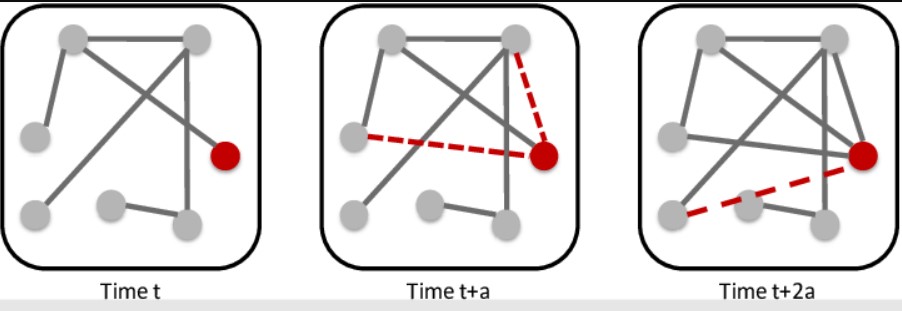Link graph is a concept that has gained prominence in recent years as a way to understand the interconnectedness of information on the internet. It involves mapping out the relationships between different websites and pages through the links that connect them. By analyzing these connections, researchers can gain insights into how information flows across the web and how certain pages are related to each other. This can be useful for a variety of purposes, such as improving search engine rankings, identifying trends in online discussions, or understanding the spread of misinformation. Overall, link graph offers a valuable tool for studying the complex network of information that shapes our online experience.

The Proximity of Your Link Network
The proximity of your link network is a crucial factor to consider when building your online presence. Having a network of links that are closely related to your own website can greatly benefit your search engine rankings and overall visibility online. When your links are in close proximity, it signals to search engines that your website is a reputable source of information within a specific niche or industry. This can help improve your website’s authority and credibility, which can lead to higher rankings in search results.
Additionally, having a network of closely related links can also drive more traffic to your website from users who are interested in the same topics or content. By strategically placing your links in close proximity to other reputable websites and online resources, you can create a strong network that can help boost your online presence and attract more visitors to your site. It is important to regularly monitor and update your link network to ensure that all of your links are relevant and beneficial to your website’s overall goals and objectives. By focusing on the proximity of your link network, you can create a strong online presence that can help you reach your target audience and achieve your desired outcomes.
Majestic’s Link Graph
Majestic’s Link Graph is a powerful tool used by digital marketers and SEO professionals to analyze and track the backlink profile of websites. With this tool, users can gain valuable insights into the link building strategies of their competitors, identify potential opportunities for link building, and monitor the health of their own website’s backlink profile. The Link Graph provides detailed data on the quantity, quality, and relevance of backlinks pointing to a website, allowing users to make informed decisions about their link building efforts.
By analyzing the Link Graph, users can identify high-quality backlinks that are helping to improve their website’s search engine rankings, as well as low-quality backlinks that may be harming their website’s SEO performance. Additionally, the Link Graph can help users identify and disavow toxic backlinks that could potentially harm their website’s reputation with search engines. Overall, Majestic’s Link Graph is a valuable tool for any digital marketer or SEO professional looking to improve their website’s search engine rankings and drive more organic traffic to their site.

Examples of Link Graphs
Link graphs are a crucial component of search engine optimization, as they help search engines like Google determine the relevance and authority of a website. There are several examples of link graphs that can impact a website’s ranking. One common example is a natural link graph, which consists of links that are earned organically, typically through high-quality content and a strong online presence. Another example is a spam link graph, which is made up of low-quality, irrelevant links that are often purchased or obtained through unethical means.
These links can harm a website’s reputation and lead to penalties from search engines. A third example is a reciprocal link graph, where websites agree to link to each other in order to boost their rankings. While this practice was once common, it is now frowned upon by search engines and can actually have a negative impact on a website’s SEO. Overall, understanding the different types of link graphs and how they can impact a website’s ranking is essential for any business looking to improve their online presence and attract more traffic. By focusing on building a natural link graph through high-quality content and ethical link building practices, businesses can improve their search engine rankings and reach a wider audience online.
Deep Dive: Link and URL Analysis
Deep dive into link and URL analysis involves a comprehensive examination of the various links and URLs present on a website or online platform. This process typically involves analyzing the structure, relevance, and quality of the links to determine their impact on the overall performance of a website. By conducting a thorough link and URL analysis, website owners can gain valuable insights into how their site is interconnected with other online resources and how these connections affect their search engine rankings.
Additionally, this analysis can help identify potential issues such as broken links, spammy links, or low-quality content that may be negatively impacting the website’s credibility and visibility on the web. By understanding the link and URL landscape of a website, businesses can make informed decisions about their online marketing strategies, content creation, and overall website optimization efforts. This deep dive analysis can provide valuable data and insights that can help improve the overall performance and effectiveness of a website in the competitive online landscape.

Assessing Domains with Link Graphs
Assessing domains with link graphs is a valuable tool for understanding the interconnectedness of websites on the internet. Link graphs provide a visual representation of the relationships between different domains, showing which sites are linked to each other and how they are connected. By analyzing link graphs, researchers can gain insights into the structure of the web and identify patterns of influence and authority within specific domains.
This information can be used to track the spread of information and ideas online, as well as to monitor the impact of marketing campaigns and search engine optimization strategies. Link graphs can also be used to identify potential sources of spam or malware, by detecting suspicious patterns of linking behavior. Overall, assessing domains with link graphs can provide valuable insights into the dynamics of the web, helping researchers to better understand the complex ecosystem of websites and online communities.
Refining Tier 1 Site Filters
Refining Tier 1 site filters is a crucial task in maintaining the integrity and effectiveness of online content moderation. By continuously improving these filters, online platforms can better identify and remove harmful or inappropriate content from their websites. This process involves constantly analyzing user behavior and feedback to identify patterns and trends in content that may be deemed unsuitable for the platform. By fine-tuning the filters, platforms can ensure that only appropriate and safe content is visible to users, creating a more positive and secure online environment.
Additionally, refining Tier 1 site filters can help prevent the spread of misinformation, hate speech, and other harmful content that can negatively impact users. It is a continuous process that requires constant monitoring and adjustment to keep up with evolving online trends and threats. By investing time and resources into this important task, online platforms can better protect their users and uphold the values and standards of their community.

